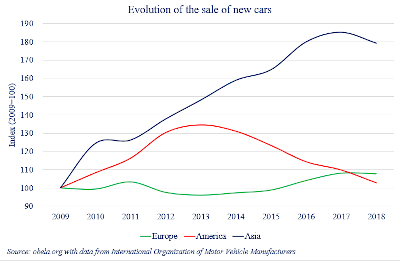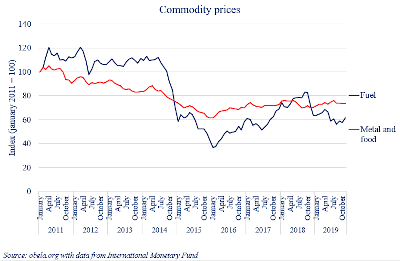The world economy: economic prospects for 2020
- blog de anegrete
- 2315 lecturas
The year 2019, has been one of the most complicated in a long time for a number of countries seen from several angles: economic growth; social cohesion; international integration and political crisis. Throughout the year, the main international organizations have cut the growth forecast for most economies, as a result of factors that have been looming for a couple of years now: the deterioration in trade relations, high levels of debt, income concentration, migratory flows, racism and a drop in productive investment.
Since the 2008 - 2009 crisis, there has been stable high growth in Asia and a slowed down growth in the United States, Europe, Latin America and Africa that apparently have reached a limit. There has been a drop in world trade since October 2018 as a result of the American trade wars; social protests of various kinds in at least 16 countries around the world and geopolitical conflicts such as brexit, which generated much uncertainty during the year and which today is more than sealed after the overwhelming victory of the conservatives in the last elections. All this has impacted private investment in both the short and medium term.

One of the main reasons for the low growth of the old continent has to do with the German deceleration which carried out reforms to implement a change in the automotive industry. This has involved greater regulation in terms of CO2 emissions with the change from fossil energy engines to electric. According to the Financial Times1, 20,000 job losses were announced in November this year between Mercedes-Benz and Audi, as a sign of the technological change in this sector.
It should be noted that so far in 2019, China has been one of the main promoters of the shift to clean energy, with Asia the leading the change into electric vehicles. The United States, in contrast, is a promoter of dirty energy. However, sales of new vehicles in Asia have also decreased, as well as in America and Europe, as shown in the graph above. By 2018, electric car sales are centred in Asia, followed by Europe and then the United States with 57%, 26% and 15% of the world market, respectively. Another factor that adds to the economic slowdown is the downward trend of world trade which is reflected in a decrease in the prices of raw materials and energy prices, which since 2011 present a declining trend as shown in the graph. The metal price index is also declining, but since it includes gold, which is on the rise, the average price is stable.

On December 13 this year, the United States and China announced "the first phase of an agreement" that implies a postponement of tariff increases by the U.S. country that came into effect on December 15 this year. Our hypothesis is that they are having a period of truce as in the closing of last year. With elections almost upon us, there does not seem to be much room for an escalation in trade tensions in the immediate future. Among the issues agreed upon are revisions to intellectual property, technology transfer, and exchange rate policies, which have generated hostility.
It is important to note that no elimination of tariffs that have already entered into force has yet been agreed upon. This time, the negotiations on the part of the American country seem to be motivated by internal U.S. political factors given that President Trump is on the road to re-election. With the impeachment passed by the House of Representatives, he needed something positive to minimize the issue. On his election tour he will be able to boast about the record highs in the stock market and the purchases China promised to make of its agricultural products, two key factors in his campaign. In this context, the markets seem to be encouraged by the truce although the basis on which the stock market gains are built seems to be weak.
While the US economy saw lower growth this year than in 2018, a further slowdown is expected in 2020, as we expected at the beginning of 20192. The Federal Reserve in its latest monetary policy decision of the year has opted to keep the federal bond benchmark rate in the range of 1.5 - 1.75% although the forecast is that when the economic slowdown intensifies, additional cuts will be made, leading to a round of cuts around the world next year. This can generate opportunities for arbitrage towards emerging countries with an impact on the exchange rate against other currencies. The final effect could be negative to international trade, which would mean one more factor to the deceleration of these economies.
The general trend of the world economy is expected to continue its slow pace in most economies with the clear contrast of the Asian economies that will continue to grow three times faster than the West, which could be affected in particular by the protests in Hong Kong and India. For the advanced economies, the prognosis is grey because the European Union's problems do not end with the UK's exit. Poland could be a candidate for a Polxit given the EU's criticism of its nationalist policies. On the other hand, Central and South America face a rather complicated situation on several fronts, with political instability, open interference from the United States and low prices of raw materials, which has significantly impacted economic growth, being together with Africa, the areas that will grow the least this year and next. The star country, Bolivia, was taken out of its growth trajectory with a coup d'état and is expected to slow down in 2020.
1 https://www.ft.com/content/5c304e72-120a-11ea-a7e6-62bf4f9e548a
2 http://obela.org/analisis/estamos-proximos-a-una-recesion-en-estados-unidos